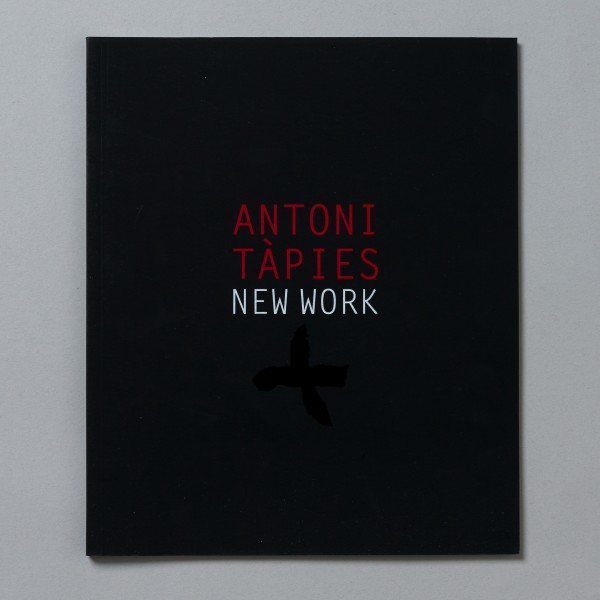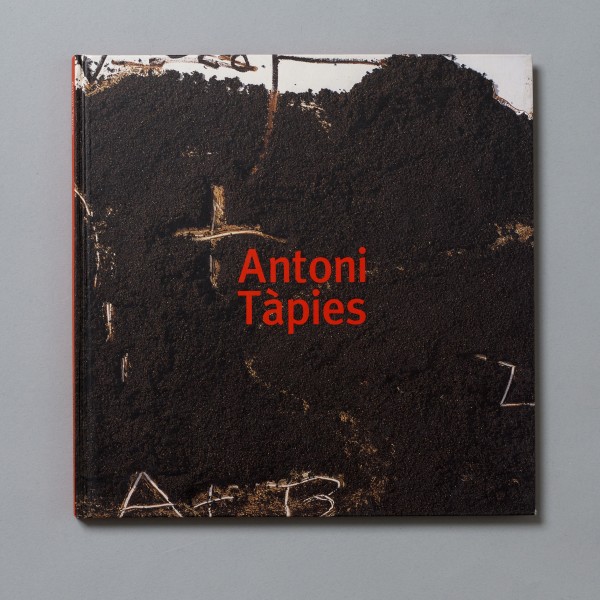Biography
Antoni Tàpies (b. 1923, Barcelona, Spain; d. 2012, Barcelona, Spain) was a Catalan painter, sculptor, printmaker and writer widely acclaimed for his ‘matter paintings’. As a pioneer of Art Informel, Tàpies used sand, dust, wood as well as paint and varnish to create alchemical paintings which connect base materials with an unseen, metaphysical world. Since the 1950s, his palette kept to raw natural colours: burnt black, earth brown, wine red, rust red, the gold of sand or marble. Born into a family of publishers, Tàpies was an intellectual who loved books and was greatly influenced by the thirteenth-century Catalan mystic Ramon Llull, who constructed his own alphabet in which individual letters had their own meanings. A private syntax of ciphers also abounds in Tàpies’ work, often appearing as an amalgam of Eastern calligraphy and Western graffiti. His ubiquitous ‘cross’ simultaneously signifies the first letter of his surname, a kiss, an erasure, a location, a vote, or a mark of faith. His works often transcend their rich materiality, its imagery identifying mutually with European Surrealism and Eastern aesthetics, evoking both physical and spiritual transformation.
Shortly after abandoning his legal studies, in 1948 Tàpies co-founded Dau al Set, the first post-war art movement in Spain. In 1950, he had his first solo exhibition at the Galeries Laietanes, Barcelona. In 1952, Tàpies gained early recognition with his participation in the Venice Biennale and at the Carnegie Institute, Pittsburgh in 1952. A year later he had his first solo exhibition in New York at the Martha Jackson Gallery. His first retrospectives were in 1962 at the Kestner-Gesellschaft, Hannover and the Solomon R. Guggenheim Museum, New York. His first major exhibition in Great Britain was at the Institute of Contemporary Arts, London (1965). In 1993 UNESCO awarded him the Picasso medal and major retrospectives were staged at the Solomon R. Guggenheim Museum (1995) and at the Museo Nacional Centro de Arte Reina Sofía (2000, 2004). The artist has received many awards including the Peace Prize from the United Nations Association in Spain (1984), the Commander of the Order of Arts and Letters from the French Government (1988), and the Golden Lion at the Venice Biennale (1993) and was made honorary member of the Royal Academy of Arts, London (1998). In 2005, he was awarded the prestigious Lissone award for his life’s work.
Read moreWorks
-
 Antoni Tàpies, Capsa amb clau / Box with key, 1987
fire clay
7 x 15 x 11.5 cm
%3Cdiv%20class%3D%22artist%22%3E%3Cspan%20class%3D%22artist%22%3E%3Cstrong%3EAntoni%20T%C3%A0pies%3C%2Fstrong%3E%3C%2Fspan%3E%3C%2Fdiv%3E%0D%3Cdiv%20class%3D%22title%22%3E%3Cem%3ECapsa%20amb%20clau%20%2F%20Box%20with%20key%3C%2Fem%3E%2C%201987%3C%2Fdiv%3E%0D%3Cdiv%20class%3D%22medium%22%3Efire%20clay%3C%2Fdiv%3E%0D%3Cdiv%20class%3D%22dimensions%22%3E7%20x%2015%20x%2011.5%20cm%3C%2Fdiv%3E
Antoni Tàpies, Capsa amb clau / Box with key, 1987
fire clay
7 x 15 x 11.5 cm
%3Cdiv%20class%3D%22artist%22%3E%3Cspan%20class%3D%22artist%22%3E%3Cstrong%3EAntoni%20T%C3%A0pies%3C%2Fstrong%3E%3C%2Fspan%3E%3C%2Fdiv%3E%0D%3Cdiv%20class%3D%22title%22%3E%3Cem%3ECapsa%20amb%20clau%20%2F%20Box%20with%20key%3C%2Fem%3E%2C%201987%3C%2Fdiv%3E%0D%3Cdiv%20class%3D%22medium%22%3Efire%20clay%3C%2Fdiv%3E%0D%3Cdiv%20class%3D%22dimensions%22%3E7%20x%2015%20x%2011.5%20cm%3C%2Fdiv%3E -
 Antoni Tapies, Untitled, 1969
paint, pencil and collage on wood
84 x 61.3 cm
%3Cdiv%20class%3D%22artist%22%3E%3Cspan%20class%3D%22artist%22%3E%3Cstrong%3EAntoni%20Tapies%3C/strong%3E%3C/span%3E%3C/div%3E%0D%3Cdiv%20class%3D%22title%22%3E%3Cem%3EUntitled%3C/em%3E%2C%201969%3C/div%3E%0D%3Cdiv%20class%3D%22medium%22%3Epaint%2C%20pencil%20and%20collage%20on%20wood%3C/div%3E%0D%3Cdiv%20class%3D%22dimensions%22%3E84%20x%2061.3%20cm%3C/div%3E
Antoni Tapies, Untitled, 1969
paint, pencil and collage on wood
84 x 61.3 cm
%3Cdiv%20class%3D%22artist%22%3E%3Cspan%20class%3D%22artist%22%3E%3Cstrong%3EAntoni%20Tapies%3C/strong%3E%3C/span%3E%3C/div%3E%0D%3Cdiv%20class%3D%22title%22%3E%3Cem%3EUntitled%3C/em%3E%2C%201969%3C/div%3E%0D%3Cdiv%20class%3D%22medium%22%3Epaint%2C%20pencil%20and%20collage%20on%20wood%3C/div%3E%0D%3Cdiv%20class%3D%22dimensions%22%3E84%20x%2061.3%20cm%3C/div%3E -
 Antoni Tàpies, Llit obert / Open Bed, 1986
enamel on fire clay
98 x 221 x 98 cm
%3Cdiv%20class%3D%22artist%22%3E%3Cspan%20class%3D%22artist%22%3E%3Cstrong%3EAntoni%20T%C3%A0pies%3C%2Fstrong%3E%3C%2Fspan%3E%3C%2Fdiv%3E%0D%3Cdiv%20class%3D%22title%22%3E%3Cem%3ELlit%20obert%20%2F%20Open%20Bed%3C%2Fem%3E%2C%201986%3C%2Fdiv%3E%0D%3Cdiv%20class%3D%22medium%22%3Eenamel%20on%20fire%20clay%3C%2Fdiv%3E%0D%3Cdiv%20class%3D%22dimensions%22%3E98%20x%20221%20x%2098%20cm%3C%2Fdiv%3E
Antoni Tàpies, Llit obert / Open Bed, 1986
enamel on fire clay
98 x 221 x 98 cm
%3Cdiv%20class%3D%22artist%22%3E%3Cspan%20class%3D%22artist%22%3E%3Cstrong%3EAntoni%20T%C3%A0pies%3C%2Fstrong%3E%3C%2Fspan%3E%3C%2Fdiv%3E%0D%3Cdiv%20class%3D%22title%22%3E%3Cem%3ELlit%20obert%20%2F%20Open%20Bed%3C%2Fem%3E%2C%201986%3C%2Fdiv%3E%0D%3Cdiv%20class%3D%22medium%22%3Eenamel%20on%20fire%20clay%3C%2Fdiv%3E%0D%3Cdiv%20class%3D%22dimensions%22%3E98%20x%20221%20x%2098%20cm%3C%2Fdiv%3E -
 Antoni Tàpies, Amuntegament / Piling, 2000
mixed media and collage on board
98 1/2 x 118 1/8 in / 250 x 300 cm
%3Cdiv%20class%3D%22artist%22%3E%3Cspan%20class%3D%22artist%22%3E%3Cstrong%3EAntoni%20T%C3%A0pies%3C%2Fstrong%3E%3C%2Fspan%3E%3C%2Fdiv%3E%0D%3Cdiv%20class%3D%22title%22%3E%3Cem%3EAmuntegament%20%2F%20Piling%3C%2Fem%3E%2C%202000%3C%2Fdiv%3E%0D%3Cdiv%20class%3D%22medium%22%3Emixed%20media%20and%20collage%20on%20board%3C%2Fdiv%3E%0D%3Cdiv%20class%3D%22dimensions%22%3E98%201%2F2%20x%20118%201%2F8%20in%20%2F%20250%20x%20300%20cm%3C%2Fdiv%3E
Antoni Tàpies, Amuntegament / Piling, 2000
mixed media and collage on board
98 1/2 x 118 1/8 in / 250 x 300 cm
%3Cdiv%20class%3D%22artist%22%3E%3Cspan%20class%3D%22artist%22%3E%3Cstrong%3EAntoni%20T%C3%A0pies%3C%2Fstrong%3E%3C%2Fspan%3E%3C%2Fdiv%3E%0D%3Cdiv%20class%3D%22title%22%3E%3Cem%3EAmuntegament%20%2F%20Piling%3C%2Fem%3E%2C%202000%3C%2Fdiv%3E%0D%3Cdiv%20class%3D%22medium%22%3Emixed%20media%20and%20collage%20on%20board%3C%2Fdiv%3E%0D%3Cdiv%20class%3D%22dimensions%22%3E98%201%2F2%20x%20118%201%2F8%20in%20%2F%20250%20x%20300%20cm%3C%2Fdiv%3E -
 Antoni Tàpies, Sutras, 2005
mixed media on wood
220 x 210 cm
Antoni Tàpies, Sutras, 2005
mixed media on wood
220 x 210 cm

































